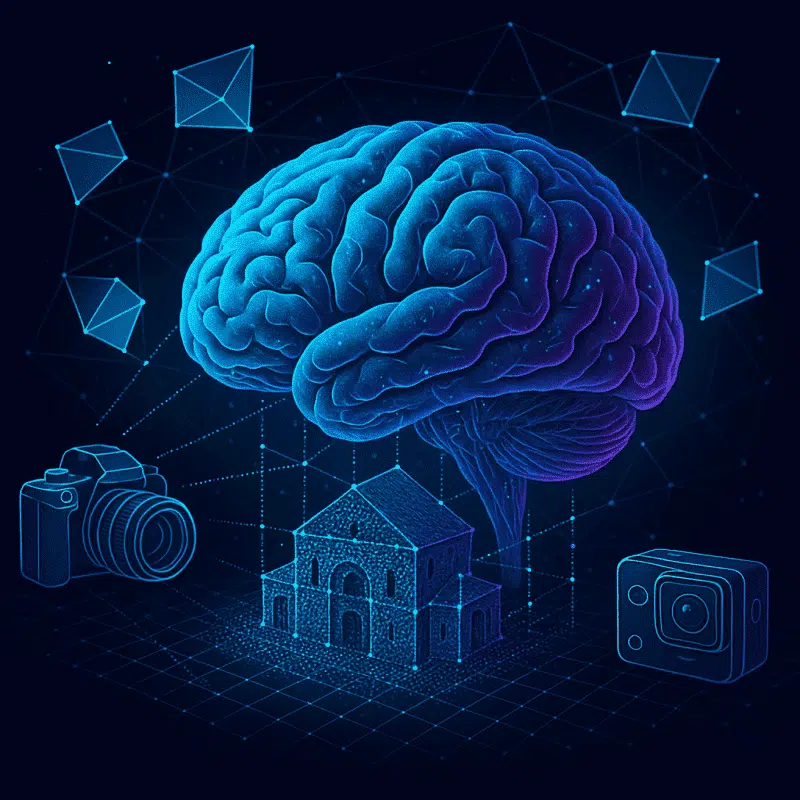In the evolving world of photogrammetry, artificial intelligence (AI) is now playing a central role. While traditional photogrammetry relies heavily on geometry and pixel comparison, the integration of AI has added automation, accuracy, and intelligent feature recognition to the workflow. Agisoft Metashape, a leader in 3D reconstruction software, has introduced several smart features powered by AI, streamlining everything from classification to depth map generation. This article explores how AI is transforming photogrammetry inside Metashape—and what it means for professionals in surveying, architecture, GIS, archaeology, and more.
Why AI in Photogrammetry?
Photogrammetry has always involved a degree of automation, but AI adds true “intelligence”—the ability to detect, classify, and interpret features without human input. This leads to:
- Faster workflows with less manual editing
- Improved object segmentation and labeling
- Better noise filtering and outlier removal
- Adaptive algorithms that adjust based on scene content
AI is especially helpful in processing large datasets from drones or terrestrial scanning, where traditional methods are time-consuming and require significant user intervention.
New AI Features in Agisoft Metashape
1. AI-Based Point Cloud Classification
Metashape now includes a machine learning-driven classification tool that automatically labels points in your dense cloud. For example, the software can distinguish between:
- Ground vs non-ground points
- Buildings, vegetation, and roads
- Powerlines, poles, and vehicles (in urban scans)
To access it:
- Go to Tools > Dense Cloud > Classify Ground Points
- Or train a custom classifier using manually labeled datasets
This automation dramatically reduces post-processing time, especially for GIS professionals working with digital terrain models (DTMs) or environmental analysis.
2. AI-Powered Feature Detection
Metashape’s newer versions include improved AI algorithms for detecting key features and optimizing image matching. This results in more robust photo alignment, especially in low-texture or repetitive environments (e.g., warehouses, rooftops).
- Improved keypoint detection in Align Photos
- Smarter tie-point filtering using neural heuristics
These AI enhancements are not only faster but also more tolerant of image variation—allowing higher accuracy from more diverse datasets.
3. Smart Depth Map Generation
One of the most critical components of a high-quality 3D mesh is the depth map. Metashape now uses AI-driven smoothing and interpolation during depth map generation, leading to:
- Cleaner geometry with fewer artifacts
- Better edge preservation (ideal for architectural features)
- Improved results in shadows and low-light conditions
This has made the Build Mesh from Depth Maps workflow more attractive, offering faster computation than dense cloud methods with comparable quality.
4. AI-Assisted Texture Mapping
AI is also used in texture blending and map generation:
- Automatic exposure and color balancing between images
- Dynamic selection of best image projections for each texture segment
- Filling of small holes and occlusions using neural inpainting
The result is more realistic textures with fewer seams or lighting inconsistencies.
Custom AI Training with Python API
Advanced users can train custom classifiers or automation routines using Metashape’s Python API. The API allows developers to:
- Access point attributes and classification labels
- Run batch detection across multiple chunks
- Integrate with external machine learning libraries like TensorFlow or PyTorch
This is ideal for organizations that want to apply domain-specific AI models—for example, identifying archaeological features, roof types, or road conditions.
Use Cases: How AI Saves Time and Boosts Precision
Urban Planning
AI classification can rapidly separate buildings, roads, vegetation, and open space in city models—accelerating land use planning and zoning analysis.
Forestry and Agriculture
Automatically detect and classify tree canopies, ground, and terrain—useful for biomass estimates and erosion monitoring.
Infrastructure Inspection
AI-enhanced mesh and texture generation improves the clarity of structural features—cracks, supports, roofing—and supports easier annotation in BIM systems.
Cultural Heritage
Use AI to identify decorative elements, reliefs, or damaged areas within complex models, saving conservators hours of manual review.
Limitations and Considerations
While AI brings many advantages, users should keep in mind:
- Classification is only as good as the training data
- Some manual validation is still required
- GPU acceleration improves AI performance dramatically—use a supported NVIDIA GPU
Conclusion
Artificial Intelligence is redefining what’s possible in photogrammetry—and Agisoft Metashape is at the forefront. From classifying dense clouds to enhancing textures and depth maps, AI allows professionals to process more data, with higher quality and less manual effort. Whether you’re a surveyor, archaeologist, engineer, or researcher, these tools can dramatically accelerate your workflow and expand what’s achievable with 3D reconstruction.
As Metashape continues to evolve, expect even more powerful smart features—making photogrammetry faster, smarter, and more accessible than ever before.


